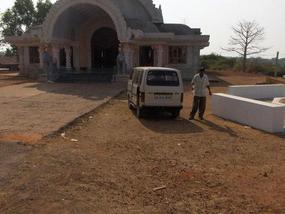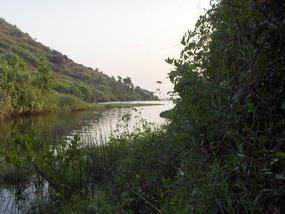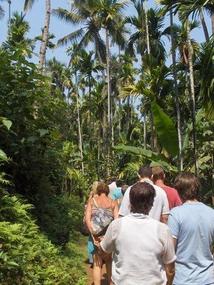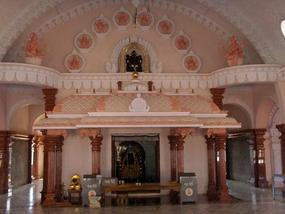Up in the morning at 8, and off in the van at 9 am. Driving to the spice plantation takes time, as do all things in India, especially when it is some 60 km away. On the way we looked for cigarettes, our driver junping out of the van at numerous locations, looking for our brand of choice, Red and White. Generally they are 12 rupees a pack, sometimes the vendor will charge 15 and keep the extra as a "commission."
Funny things, these Indian cigarettes
. For one, hardly any Indians smoke, but almost all westerners do. The cigarettes are 64 mm long, and made from indian tobacco. they come in packs of 10, and one must keep 6 or 7 packs around, as they burn so fast, you can light one, look away for a moment, and then put it out, as it has already burned down to your fingers. Don't blink when smoking them, you'll just have to light another. At least they are dirt cheap, and that is dirt in the literal sense. They seem to be made at least partially from it. It's like a crapshoot, you never know what you are going to smoke when you light one. Hair, hash, rubber, oil, well, heck, once I lit one and smelled Nag Champa.
After many tries, our determined taxi driver stopped once more in sight of the spice plantation we had been searching for. We told him to get "wills" cigarettes, which seemed to be the only ones available in the south of Goa. Gold Flake are available anywhere, but are not near as good as the others. He finally cam out with our smokes, and we were ready
.
Upon entrance to the plantation, they throw flower petals over you, and put a sort of lei made from white flowers on your neck. You then go in for tea and a talk, sometimes humorous, about the plantation and the uses of the spices they grow there. Pepper, cardamom, cinnamon, nutmeg, cashew, mace and clove, and of course, the famous betel nut, which is India's legal drug and is supposed to produce a mild high when chewed.
After the tour you get lunch, all fresh and delicious and includes fish, fruit, rice of numerous kinds, a couple of curries, bread, and more. Also with the lunch comes a little shot of "Fenney" a kind of local moonshine made most often from the cashew fruit. "For medicine, " they tell you.
We saw all kinds of spices on the tour, about an hour and an easy walk through a lush jungle. Elephants went wading in the river, and also they gave us a demonstration on palm tree climbing, inviting anyone else to try it. I declined, being on holiday, and not inclined to that much work
. Even the obnoxious young group of partying English behind us did not want to have a go, so off we went to our tasty lunch. And the famous but deadly fenney.
Fenney tastes a bit like grappa, maybe a bit of calvados, and similar to some home made austrian schnapps I have had in the past. It is not sweet, and has a unique flavor. Also it is about 100 proof, more if it is made right. One of our german acquaintances staying at the complex described in broken english: " Fenney. . .two years. . .(and, covering his eyes). . .Blind. . " Made me want to taste some. Both Turtle and I agreed it was quite nice, and made up our minds to get a bottle and try it later.
Leaving the spice plantation our driver took us to a temple of Vishnu, which we were given a barefoot tour of (remove your shoes when entering any building in india, especially a temple). We saw a solid silver carrying chair used for festivals and holy days, and the interior is ornate, with silver fixtures everywhere. There is a sort of inner sanctum in which a statue of Vishnu, the creator is housed, and no-one can go in there, though it is visible from the main prayer area
. There is a hall around this room, and those with a truly urgent prayer can pray with their head on the door, as this is the closest point to Vishnu. In the front, people buy flowers to leave as offerings to the diety, dab their forheads with red powder, and pray. Outside there is a lamp tower about 40 feet high, the oil lamps having been long since replaced by electric light bulbs, and this is also lit for special occasions.
Each social stratum, or caste (though castes are supposed to be illegal) worships a different diety, Vishnu, being one of the higher ones, is of course worshipped by the higher (and generally lighter complected) Brahmin caste. Later on we went to the driver's temple, the temple of Gonesh, whose realm seems to be community, family, and work ethic. Gonesh was the son of one of the dieties, was allowed to see something forbidden, and had his head chopped off (I think by vishnu) for breaking the diety rules. His father put up such a fuss that Vishnu brought him back to life, giving him a new head, except the head was that of an elephant. There you go, lower castes, all the good human heads are taken, all we have left are these elephant heads. You will get that or nothing. 200 rupees now, please.
All in all Gonesh seems like a pretty good sort, the feel of the temple was much more comfortable and laid back than the more uppity-seeming temple of Vishnu. Plus we might have been biased, as our driver was quite a good fellow, and had taken good care of us
.
Between temples, our driver stopped a couple of places in the capital (and not touristy at all) city of Panjim, rapid firing in his language with a couple of people he seemed to know here and there (everyone seems to know everyone here, and they probably do), and then squeezed the tiny van into an even tinier parking spot. " Guitar-- there. . " he motioned, and stepped out to lead us there. After the experience of the day before, I got to thinking of ways in which I could smooth over the offense he would take when his cousin's guitars were refused, all being made out of metal, concrete, plastic bottles, or some other unlikely and unsuitable material. Fortunately he brought us down the street to a door painted with a violin on it and the name "Pedro Fernandez Music" on it.
Pedro turned out to be an older Indian gentleman, about sixty, I reckon, well-spoken and with a wall full of guitars of chinese and indian make. Indian guitars, some of which are well-made, carry funny clone names. "Givson" and "Funder" among them. All of them had actual price tags on them, the first time I had seen such in this country, and "Pedro" let me try as many as I wanted, finally I settled on one of chinese make that played well, and suited my needs: not too heavy, good tone, built-in pickup, action lower than 5 inches from the fretboard, not made from marble, etc. The price was something like 5250 rupees, and I got him to throw in an extra padded gig bag with it for 5000. A little more than I wanted to pay (about a hundred and change US), but all in all a good little instrument, functional and good-looking. Hopefully it will survive Singapore air lines.
Mr. Fernandez's shop was apparently the only one in the area, and was filled with good-quality instruments, even if they were made by Kromer, Takamuni, and Givson. We bade Pedro a fond farewell, him sticking his label on the inside and promising to fix anything on the guitar for a lifetime. After Gonesh, we got dropped off in Arumbol once again, and made our way up to the freshwater lake on the other side of the hill. With the name "Sweet Lake" in India, it just may be anything but. .
On the way we bought a couple of "big" beers (750 ml) and a bottle of fenney for a total of 120 rupees ( about three dollars). Finding the "road" little more than a walkway that taxi vans squeezed down, and walked through a row of bars, restaurants and shop booths, one vendor calling "everything one rupee!" as we went by. The prices drop sharply the closer the monsoon season is.
After a km or so we made it to sweet lake, which is a freshwater lake, not even polluted, with a stretch of sand about 500 ft wide separating it from the ocean. How it does not become salinized in the monsoon season when the ocean rears up 3 meters high is beyond me. We found a nice spot, watched a beautiful sunset at 6:30, stopped in at the Rice Bowl on the way, then headed home to the Villa Elena Complex.
Once there, I pulled out the guitar, and played a few songs for the people there, including a funny american guy, Heath, from colorado, and his newfound love, a russian girl, beautiful and fiery, but with an unpronouncable name. . I guess Love knows no language barrier. Also then we started laying into the Fenney.
Fenny goes down smooth, with a little drip of lemon juice, even better. It does not taste as loaded as it is, and it is just fine until one tries to stand up. Then the world wobbles on it's axis.
Of course, I did not really stand up until 4 in the morning rolled round again, with Ray sleeping peacefully in the hammock chair, Turtle slurring "Cmon mate, we gotta finish the bottle!" and myself knowing that if I stayed up one more second, I'd not be awake.
Such was my second day in Goa. . .
The spice plantation and Fenney
Thursday, March 02, 2006
 South Goa (panjim), India
South Goa (panjim), India
Other Entries
-
1So much to do. .
Jan 0952 days prior Boston, United Statesphoto_camera0videocam 0comment 1
Boston, United Statesphoto_camera0videocam 0comment 1 -
2Itinerary complete!
Feb 0624 days prior Boston, United Statesphoto_camera2videocam 0comment 0
Boston, United Statesphoto_camera2videocam 0comment 0 -
3Londontown
Feb 228 days prior London, United Kingdomphoto_camera3videocam 0comment 0
London, United Kingdomphoto_camera3videocam 0comment 0 -
4Ahh. . London. .I will miss thee. .
Feb 255 days prior London, United Kingdomphoto_camera5videocam 0comment 0
London, United Kingdomphoto_camera5videocam 0comment 0 -
5Touchdown. . Mumbai
Feb 273 days prior Mumbai, Indiaphoto_camera3videocam 0comment 0
Mumbai, Indiaphoto_camera3videocam 0comment 0 -
6Mumbai Day 2: Tickets to Goa!
Feb 273 days prior Mumbai, Indiaphoto_camera0videocam 0comment 0
Mumbai, Indiaphoto_camera0videocam 0comment 0 -
7The long train to Goa
Feb 282 days prior Goa, Indiaphoto_camera5videocam 0comment 0
Goa, Indiaphoto_camera5videocam 0comment 0 -
8Lazy days in Arambol, Goa
Mar 011 day prior Arambol, Indiaphoto_camera5videocam 0comment 0
Arambol, Indiaphoto_camera5videocam 0comment 0 -
9The spice plantation and Fenney
Mar 02 South Goa (panjim), Indiaphoto_camera5videocam 0comment 0
South Goa (panjim), Indiaphoto_camera5videocam 0comment 0 -
10Waxing philosophical. .
Mar 064 days later Arambol, Goa, Indiaphoto_camera4videocam 0comment 0
Arambol, Goa, Indiaphoto_camera4videocam 0comment 0 -
11My first gig in India, a rave, and sweet goodbyes.
Mar 064 days later Arambol, Goa, Indiaphoto_camera4videocam 0comment 0
Arambol, Goa, Indiaphoto_camera4videocam 0comment 0 -
12Goa Extensions, Enfields and Freak Storms. .
Mar 086 days later Arambol, Goa, Indiaphoto_camera3videocam 0comment 1
Arambol, Goa, Indiaphoto_camera3videocam 0comment 1 -
13Scooters, forts, and the search for Rocinante
Mar 1311 days later Anjuna, Goa, Indiaphoto_camera5videocam 0comment 0
Anjuna, Goa, Indiaphoto_camera5videocam 0comment 0 -
14Rocinante! The Harley of India. . .
Mar 1614 days later Arambol, Indiaphoto_camera5videocam 0comment 0
Arambol, Indiaphoto_camera5videocam 0comment 0 -
15Booze and drugs and rock and roll.
Mar 2624 days later Goa, Indiaphoto_camera5videocam 0comment 1
Goa, Indiaphoto_camera5videocam 0comment 1 -
16Mapusa. . .
Mar 3028 days later Mapusa, Goa, Indiaphoto_camera5videocam 0comment 0
Mapusa, Goa, Indiaphoto_camera5videocam 0comment 0 -
17The dark side of Paradise. .
Mar 3129 days later Arambol, Goa, Indiaphoto_camera3videocam 0comment 0
Arambol, Goa, Indiaphoto_camera3videocam 0comment 0 -
18Language theory, and so many choices.
Apr 0231 days later Arambol, Indiaphoto_camera2videocam 0comment 0
Arambol, Indiaphoto_camera2videocam 0comment 0 -
19Dead and rotting things on the beach.
Apr 0332 days later Arambol, Goa, Indiaphoto_camera3videocam 0comment 0
Arambol, Goa, Indiaphoto_camera3videocam 0comment 0 -
20Rocinante gets to gallop
Apr 0635 days later Palolem, Indiaphoto_camera5videocam 0comment 0
Palolem, Indiaphoto_camera5videocam 0comment 0 -
21Itchy feet and fading smiles.
Apr 0938 days later Palolem Beach, Indiaphoto_camera5videocam 0comment 0
Palolem Beach, Indiaphoto_camera5videocam 0comment 0 -
22Scams advice, and "The Crew". .
Apr 1342 days later Palolem Beach, Indiaphoto_camera5videocam 0comment 1
Palolem Beach, Indiaphoto_camera5videocam 0comment 1 -
23The time machine, The Darkness and The Light. .
Apr 1847 days later Palolem beach, Indiaphoto_camera5videocam 0comment 0
Palolem beach, Indiaphoto_camera5videocam 0comment 0 -
24Going Native
Apr 2150 days later Still in Palolem, Indiaphoto_camera5videocam 0comment 0
Still in Palolem, Indiaphoto_camera5videocam 0comment 0 -
25Leaving Palolem. .
Apr 2251 days later Palolem, Indiaphoto_camera5videocam 0comment 0
Palolem, Indiaphoto_camera5videocam 0comment 0 -
26Hard Core Karnataka: part 1
Apr 2352 days later Yaragatti, Karnataka, Indiaphoto_camera2videocam 0comment 0
Yaragatti, Karnataka, Indiaphoto_camera2videocam 0comment 0 -
27Hard Core Karnataka: part 2
Apr 2352 days later Yaragatti, Karnataka, Indiaphoto_camera4videocam 0comment 0
Yaragatti, Karnataka, Indiaphoto_camera4videocam 0comment 0

 South Goa (panjim), India
South Goa (panjim), India







2025-05-22